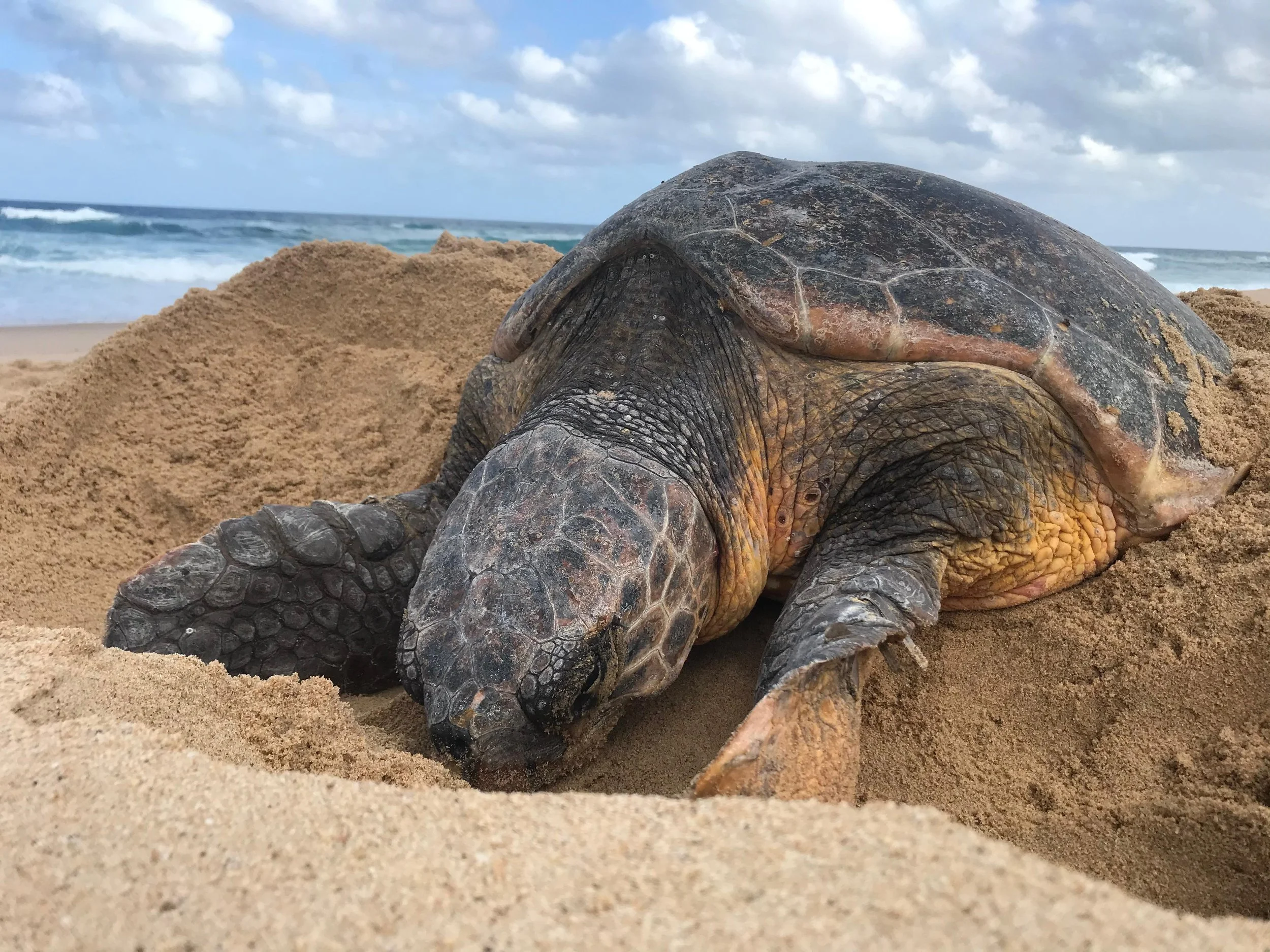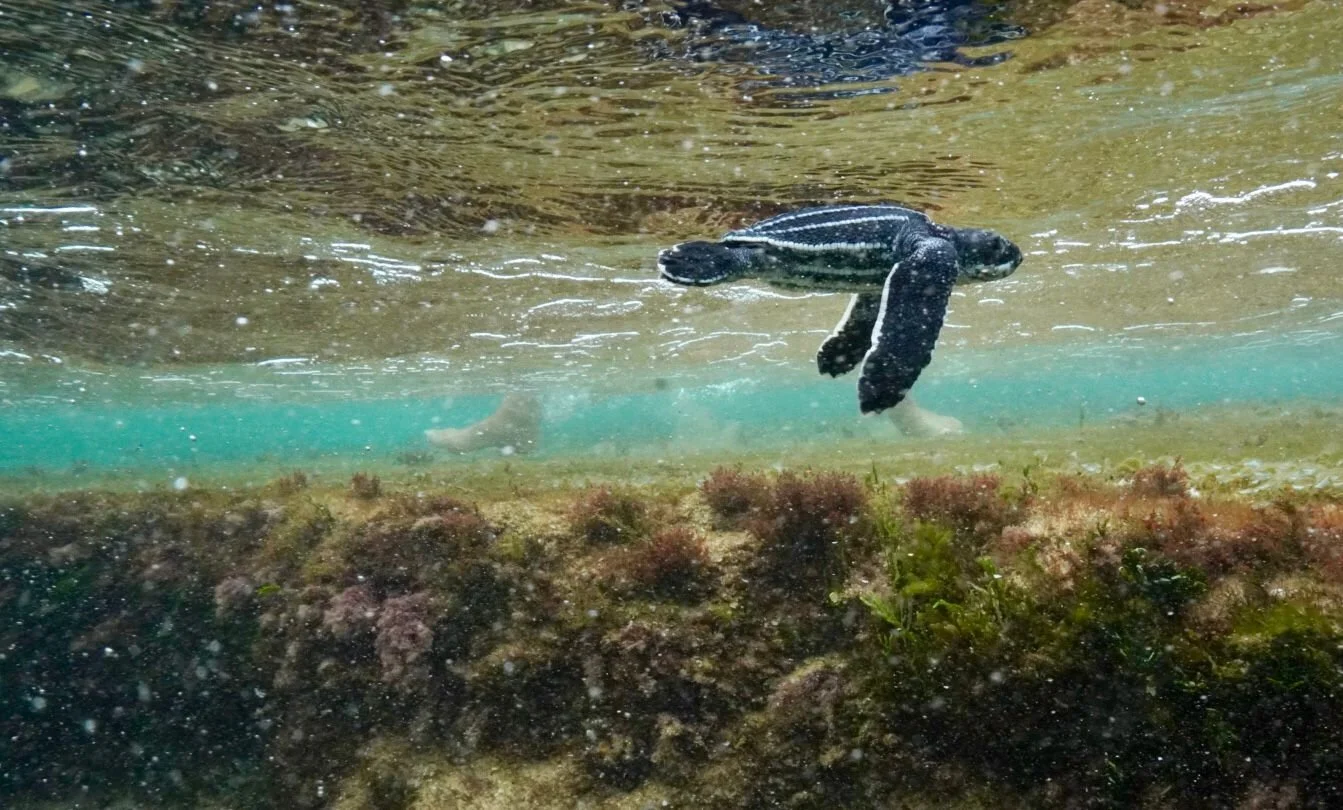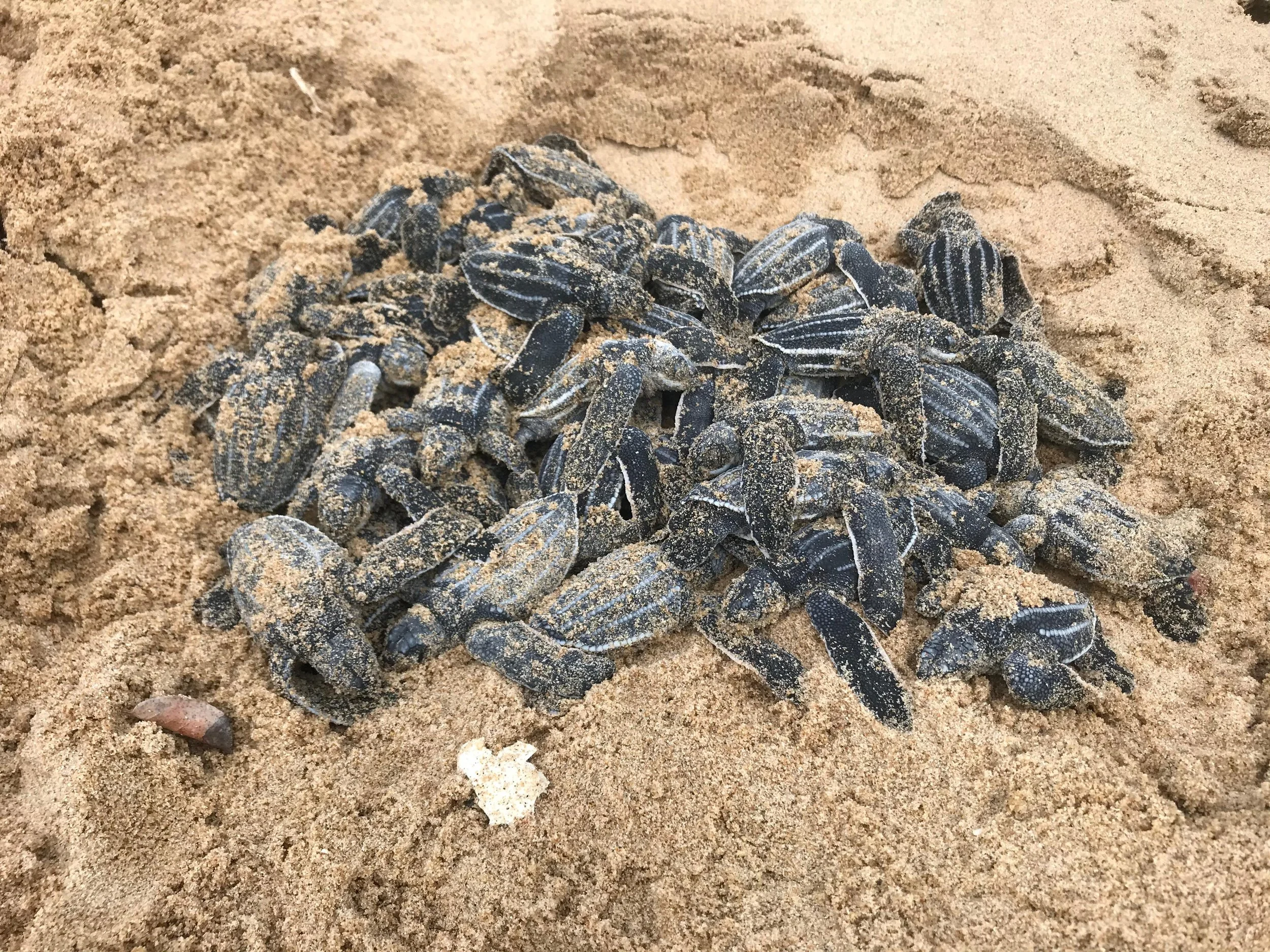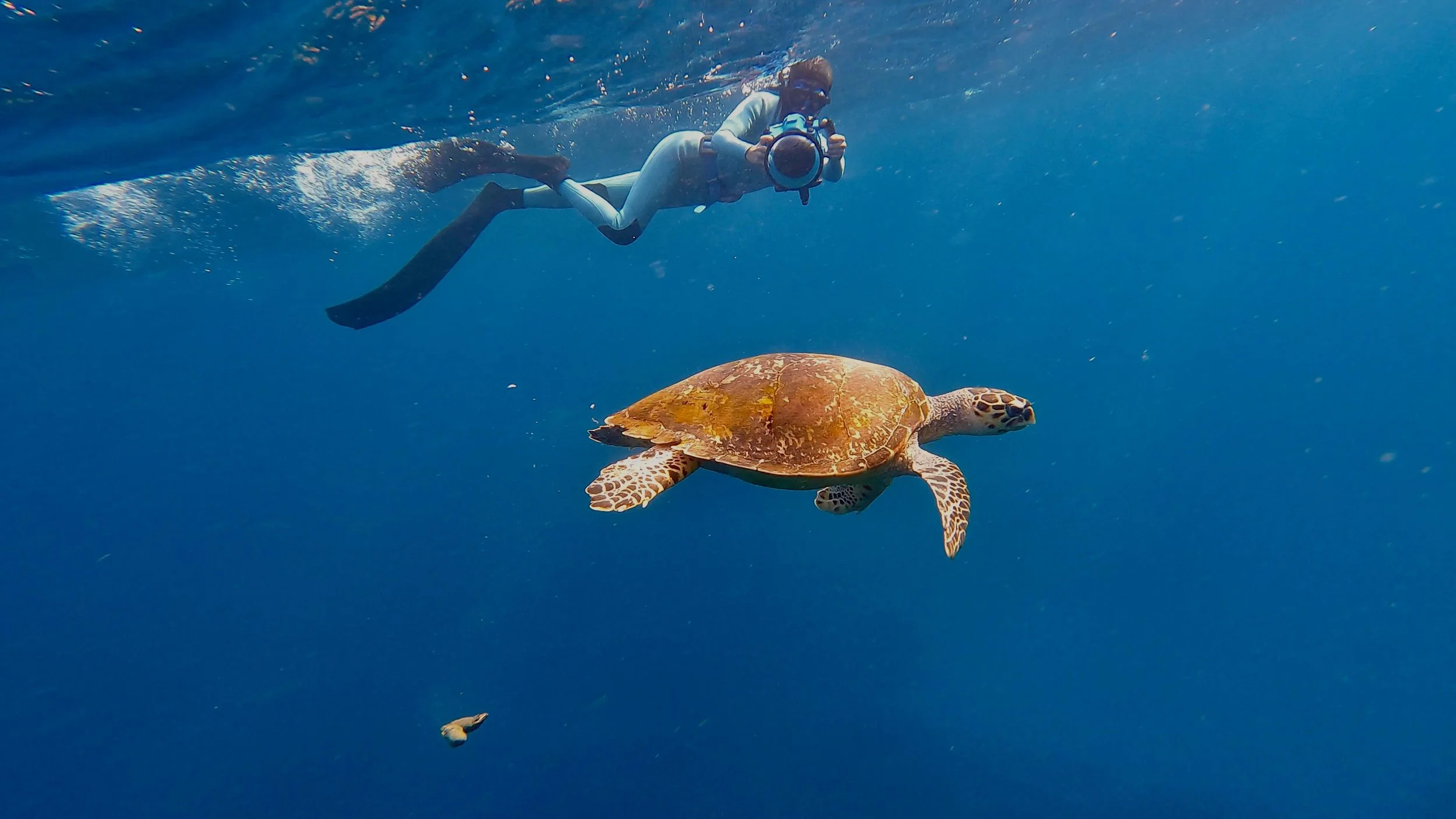
Tag a Turtle
Buy a Tag
𓆉
Name Your Turtle
𓆉
Help Protect Its Future
𓆉
Buy a Tag 𓆉 Name Your Turtle 𓆉 Help Protect Its Future 𓆉
Photo by Andy Coetzee
Why do turtles move us?
They are our magnet, the iconic creatures that have pulled guests to Maputaland for years, and yet they are niche creatures. They have also been squeezed into a less-than-helpful corner of the global conversation. You’ve heard it: “think of the turtles” every time someone reaches for a plastic straw. The guilt passes, and you may think, “who cares about turtles - just give me my smoothie.” Others care so deeply that they’re angry we’re even acknowledging the first group.
Season after season we come back to this moment: how do we talk about turtles?
Photo by Andy Coetzee
Then comes October and it’s once again time to talk about our USP (unique selling point for those of you that aren’t into business). We start reeling off facts about them to convince people to come to our lodge and see them (leatherback turtles are massive, did we mention that?)
This year, however, we wanted to go a little deeper. The impact of a seeing an old leatherback mother trying to lay her eggs on the dune can sharply and unexpectedly overwhelm a person to tears, and yet they have a brain roughly the size of a small peanut.
So the question is, why? Why have they even become a magnet for the area? (did we mention they are massive?) Why do they force people from all walks of life to the point of tears? There’s no easy explanation - turtles just look like a moving piece of oversized luggage with a rugby ball tied to the end (did we mention they are ginormous?). Edit: (ignore the fact that someone who cares deeply about conservation just said a turtle looks like a piece of luggage.
In short, and without rude comparisons, why does this creature make us care at all? Long before marketing and capitalism, would our early hominid ancestors have stopped to watch a gigantic turtle haul herself up a dune for two hours, decide the spot wasn’t quite right, and try again later? We firmly believe so.
Turtles have come to mean more than plastic and marketability. What gets us is how we feel on the beach when one appears - the quiet shock of it. It’s a ritual older than we are: tiny hatchlings facing the onslaught of life, mothers returning from far oceans to lay again almost exactly where they began.
The tug on the heart isn’t only about fragility under human pressure, or the distances they travel, or the effort of that dune climb. Rather, it’s the recognition that there have been rituals and lives of creatures that are independent of us and will be there after us (hopefully).
Photo by Andy Coetzee
From here, our job is practical. We’re a small lodge that happens to share a coastline with an important rookery, a nesting area where female turtles return, season after season, to lay their eggs. With all our philosophising about why turtles matter, we’d like to invite you to dive into their world with us this season. Partnering with Ezemvelo KZN Wildlife, this page invites you to sponsor a flipper tag which will assist in funding turtle monitors and turtle conservation whilst give you the opportunity to name and “sponsor” a turtle with careful, delayed updates. With permission from turtles.co.za, we’ve also boiled down Masters/PhD research into plain-English notes so you can dig deeper without the jargon. Our hope is that turtles become more than the symbol of a guilt trip from a well-meaning friend, or the sheer overwhelming size (yes they are large creatures) but that they become something you understand and want to protect because it’s right.
Photo by Andy Coetzee
Buy a Tag
How Does It Work?
You can “Tag” a Turtle for R500.00
After your purchase, you will receive a welcome email and details about your purchase. Once a turtle has been tagged, you will receive an email with your Turtles unique tag number, details about the turtle, nesting info and will be given the opportunity to name your turtle.
Throughout the turtle season and seasons to come, whenever data is received by us on your turtle, we will share with you via email.
At the end of turtle season, you will receive a season summary report. This will includes the total number of turtles tagged, sightings recorded and highlights from the field. The report will also outline when you can expect to hear more about your turtle.
Tags are limited to 30 as this is part of our pilot programme.
What happens with the proceeds?
All funds received after payment processing fees will contribute towards turtle research and conservation in Maputaland. In partnership with the Tim Neary Turtle Trust & EKZN Wildlife. Read the full Terms and Conditions here.
Turtle Research
With permission from SA Turtles, we’ve used and summarised insights from selected articles. We’ve kept things plain and short here, but these are summaries. For full context - methods, caveats, and the “why” behind the findings -we strongly recommend reading each paper in full and exploring the broader collection available through SA Turtles.
-
Total length: ~1.8–2.0 m (max around ~2.1 m)
Weight: typically ~300–500 kg (heavier individuals occur)
Roaming from Maputaland: thousands of km across the SW Indian Ocean/Mozambique Channel; some individuals travel up to ~8,000 km across ocean basins
Age at first nesting: ~15–20 years
Lifespan: ~50+ years
-
Total length: ~1.0–1.4 m (rarely larger)
Weight: ~70–180 kg
Roaming from Maputaland: commonly ~500–2,500 km (Mozambique Channel and SW Indian Ocean), then back to this coast to nest
Age at first nesting: ~30–36 years
Lifespan: ~70+ years
-
They are local people from villages near to the monitored beaches, trained each year to monitor nesting turtles. Monitors work set patrol shifts at night (and early morning) along fixed stretches of coast. When they spot a turtle, they hold back until she’s settled (calm, digging or laying), then approach quietly from behind the shoulder using a single red light.
They first check for a flipper tag.
If tagged: they note the number and what she’s doing (e.g., laying, covering, returning).
If not tagged: they fit a small, numbered metal tag quickly and carefully, then step back.
Right there on the beach they log the encounter on a phone (species, time, segment, activity, simple measurements if appropriate, and any notes). Those records feed into Ezemvelo KZN Wildlife’s database, which powers the season summaries you see here. For turtle safety, updates are shared later (24–72 hours) and only by beach segment, not GPS.
-
The 2024/25 interim shows loggerheads broadly steady vs last year (7,288 tracks; 4,199 nests; 634 distinct females), while leatherbacks dipped (508 tracks; 483 nests; 63 distinct females). Nesting success sits around ~57% for loggerheads and ~95% for leatherbacks—typical for each species. The long-term loggerhead trend is “up then stable,” with big gains since the 1960s protection era; leatherbacks show more year-to-year wobble and a small, sensitive population. In short: your support helps keep a good thing steady for loggerheads and shores up a thin margin for leatherbacks.
2024/2025 Interim Sea Turtle Nesting Report — Santosh Bachoo -
The biggest threats are mostly human: fishing bycatch (longlines, gillnets and trawls catching or drowning turtles), coastal lighting and development that deter nesting or disorient hatchlings, disturbance on beaches (vehicles, dogs, crowds) that causes false crawls or exposes nests, and plastic—both ingestion (leatherbacks mistake bags for jellyfish) and entanglement. Add climate change (hotter sand skews sex ratios toward females; storms and sea-level rise wash out nests) and you have a tight list of drivers. Predators (crabs, dogs, jackals) take a share too, especially where dunes are degraded. The fixes are practical: darker beaches, intact dunes, careful guiding, cleaner seas, and smarter, turtle-safe fishing.
-
A Maputaland-based study tested sensory drivers for loggerheads—chemical, light and “social” cues. It found artificial light (as low as ~0.045–0.5 lux) deters females from emerging, while even dramatic natural flashes (lightning up to ~8.2 lux) didn’t show the same effect on where/when turtles come up. The high-density “hotspot” vs low-density areas weren’t explained by simple beach shape; chemical cues (elevated sulfide concentrations) likely play a role. Bottom line: Stick to red lights aimed at your feet when on the turtle tour
Environmental cues and sensory preferences directing the nesting process in loggerhead turtles (Maputaland) — Wayne Brazier -
For sea turtles, temperature sets the sex. Nests that average around 29–30 °C produce mostly females; cooler nests make more males. Toward the end of incubation, the embryos add about +1 °C of their own heat, so a nest can run slightly warmer than the surrounding sand. Shade, dune plants and weekly weather all shift temperatures. Because sex tracks temperature so closely, keeping dune vegetation and calm, low-light nights helps avoid pushing nests too warm—and long-term temperature checks let us spot worrying trends early.
Incubation temperature, hatching success and hatchling sex ratios (KZN) — Melissa K. Boonzaaier (MSc, 2011) -
Yes, by coastline, not by centimetre. Both loggerheads and leatherbacks return to the same rookery (this coast) to lay eggs. Within that coastline, loggerheads tend to cluster nests within a few kilometres of the same stretch during a season and often use overlapping “neighbourhoods” in later seasons. Leatherbacks also come back to this coast to nest but spread out more along the beach between years. Practically, it means small pieces of shoreline can be disproportionately important for loggerheads, while leatherbacks benefit from a broader, unbroken coastline with multiple suitable options.
Botha, M.H. (MSc). Nest site fidelity and nest site selection of loggerhead and leatherback turtles, KZN. -
Across roughly 900+ nests monitored, the biggest losses came from predators, with erosion/high tides next. On this coast that typically means ghost crabs working into chambers, monitor lizards, jackals/dogs, and small carnivores/birds taking exposed eggs or hatchlings. Heavy surf and spring tides can undercut the dune face or wash out a nest entirely. The fix isn’t complicated: keep access tidy, keep groups small and quiet, and protect dune vegetation. Stable, lightly used dune faces and good plant cover make nests harder to find, harder to dig up, and less likely to sit in the path of the next big swell.
-
Casuarina equisetifolia is an Australian “she-oak” planted along parts of the KZN coast decades ago as windbreaks and for dune stabilisation/ornamental shade. It does that job a bit too well: roots knit dunes into hard, steep faces; needle-like litter mats the sand; and the result is less loose, workable sand. Where Casuarina takes hold, adults struggle to dig and hatchlings struggle to emerge. Controlling or removing these trees lets dunes behave naturally again—softer slopes, shifting sand—which directly improves nesting and emergence on the same beaches visitors love. It’s one of the simplest habitat wins we can support locally.
de Vos, D. (MSc). Effects of Casuarina on sea turtle nesting beaches.
-
Turtles don’t use the beach evenly. They home in on short “good” stretches where four things line up: a dark coast, an easy surf run-up, workable dune sand/vegetation, and sometimes freshwater seeps from behind the beach. Change any one: add bright lights, harden the dunes, or churn the swash zone and nesting drops or shifts. Loggerheads cluster tightly in these spots; leatherbacks return to the same coast but spread out more, so they need longer, unbroken shoreline.
Nest site selection and nest site fidelity in sea turtles (iSimangaliso) — Michaela J. King
-
Laying (nesting): mid-October to mid-March, peaking November–January.
Loggerhead peak: Nov–Dec
Leatherback peak: Dec–Jan
Hatching (emergence): roughly December to April/May, peaking January–March (about 55–70 days after eggs are laid, depending on sand temperature).





